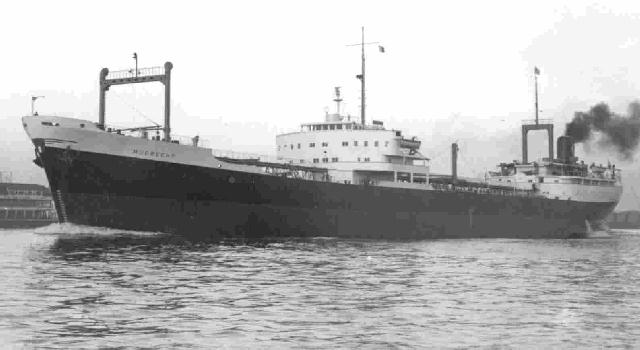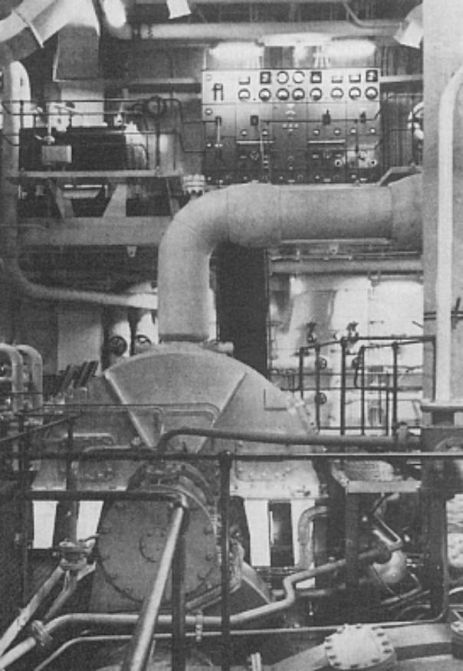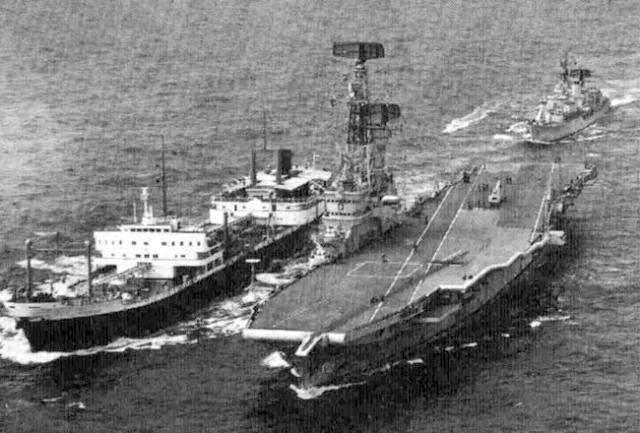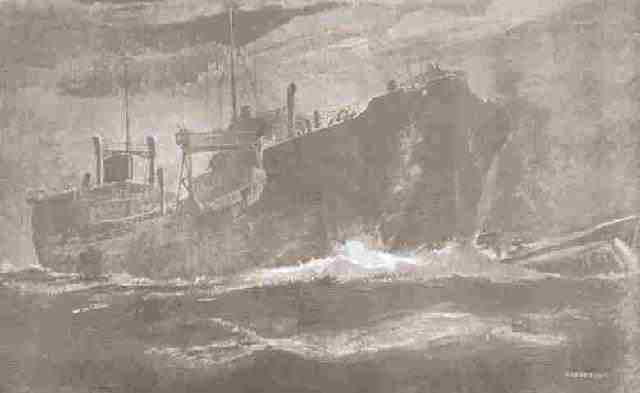![]()
ms Mijdrecht

My very last ship was the ms Mijdrecht shown in this picture. It also was my shortest trip ever; from Rotterdam to Antwerp and back again in four days. To be exact from 2nd of August to the 6th of Augustus 1963. Back to the old school banks again to better prepare myself for a career ashore. Quite a change, but then change is the only constant factor in life.

The Pametrada (Parsons And Marine Engineering Turbine Research And Development Association) steam turbine in the engine room on board the Mijdrecht. Quite a small contraption compared to the bulky diesel motors but very uneconomic because of the high fuel consumption. Due to the rising cost of fuel oil the use of steam turbines came soon to an end.

In 1960 the Mijdrecht participated as a bunker ship in the voyage to Dutch New Guinea of the aircraft carrier Karel Doorman and the frigates Groningen en Limburg.The photo shows the ship in full action. More information and nice pictures can be found when clicked here.

This is the previous Mijdrecht, 7493 tons, built in 1931 and owned by Phs. Van Ommeren at Rotterdam. What I can read from the picture is the ship's name, Du for Dutch, a date 8-22-43, Anch meaning probably Anchored and USCG which is the United States Coast Guard. However, no indication were the ship was anchored then. Ship maintenance leaves to be desired! It really looks battle weary in this picture. I do not know what the further ship's history is. Well I know now and it is quite an interesting war time story.
In early March, 1942 the ms Mijdrecht was part of convoy OB-293 and on its way from Oban to Trinidad. The convoy consisted of 37 ships with a total gross tonnage of 231.824 OB stood for Outward Bound, meaning from the UK to the America's. In total six Dutch ships participated in the convoy, which were the ss Woensdrecht, another Van Ommeren tanker which was torpedoed by the U-515 on the 12th of September of that same year, ss Kelbergen, ss Leerdam, ss Ulysses and the ss IJsselhaven. The convoy proceeded at a speed of 8 knots. The convoy was spotted by the ill famous commander Prien of the U-47 in position 60 N and 13 W, who was responsible for sinking 28 allied ships. Due to the new developed strategy of Admiral Dönitz, the so called 'Rudel' technique, Prien was not allowed to attack - yet. 'Rudel' stands for 'Pack'. The orders were:
1. Locate a convoy
2. Inform other subs in the vicinity and HQ
3. Attack the convoy in the pack fashion
The amount of damage to the hull caused by the torpedo fired by the German sub U-70 was, as can been see from this photo, quite extensive. It is surprising that the Mijdrecht attacked the U-boat after being torpedoed and with that kind of damage.
The war time ms Mijdrecht which is shown in the picture above, which was under the command of Capt J. Swart, was attacked by the U-70, commanded by lieutenant Joachim Matz, one of the subs in the pack. It was a clear night and the attack occurred at 05.50 AM on the 7th of March 1941. A torpedo slammed into the Mijdrecht which was lying still in the water to pick up survivors from the British tanker "Delilian" which has previously been torpedoed by the U-70. A sitting duck situation. The torpedo hit the Mijdrecht just in front of the engine room and in the cofferdam, causing great damage. Bunker oil leaked into the engine room which however could still be used. The stern of the ship sank a couple of meters, but the ship got under way again. Captain Swart was at that moment on deck with the survivors of the Delilian. The Chief Officer on the bridge suddenly sighted the U-70 to the starboard side of the ship getting ready to take a repeat shot at the Mijdrecht to finish it off. However, the Chief Officer after sighting the submarine immediately planned to ram the U-boat. The Radio Officer was at the wheel at that moment and was given the order 'Hard to starboard' and 'We are going to ram them', which they did shortly afterwards when the ship was doing 7 miles again. The attack from a defenceless, already torpedoed tanker was for the sub totally unexpected and to horror and surprise of the crew hit the U-70. The sub lost both periscopes and the command tower was damaged. Water poured into the ship from a hole were once the radio direction finder was protruding through the hull. The sub rolled over and disappeared under the keel of the ship. It was seen shortly after at the portside with the stern raised about 4 meters above the sea after which the sub marine disappeared. Later the sub reappeared on the surface and when the hatch was opened 6 crew members were blown out of the ship by the tremendous air pressure which existed inside the hull. Half an hour later the U-70 sank taking 20 crew members down with it. Lieutenant Matz and 25 survivors were picked by one of the ships of the convoy and taken prisoner.

This aquarelle portrays the moment that the ms Mijdrecht hit the U-70 at the command tower position. It is now hanging in the Town hall of the town called "De Ronde Venen" which consists now of the cities Mijdrecht, Vinkeveen, Waverveen en Wilnis.
The damaged Mijdrecht returned to
Scotland and entered the river Clyde on the 9th of March 1941 for repair. On the
hull about 12 meters of grey paint could be seen as evidence and proof of the
incident. Captain Swart received congratulations from the British Admiralty the
day after the incident and received Lloyd's 'War Medal for Bravery at Sea' and
was appointed to 'Honorary Officer of the Order of the British Empire'. He and
the Chief Engineer Van der Wilt received the 'Bronze Cross' from the Dutch
government in exile. Well, yes, the Dutch are a sparing, frugal race except when
it comes to rewarding the military and government desk tigers. To some the idea
of a Gold Cross for a simple Merchant Navy Captain is quite an appalling thought.
Chief Officer De Bruyn who initiated the attack, boatswain Velthuis, Radio
Officer Van den Berg and the gunners Wiersma and Icke received a Honourable
Mention and the entire crew received a Charter signed personally by Winston
Churchill. After the war in 1948 (!) the ship received a bronze (again!)
commemoration plate which was fastened to the ship and which was unveiled by the
Dutch Minister of Tranport and Public Works D.G.N. Spitzen. The timing was
somewhat awkward as Captain Swart had died in the mean time. The Mijdrecht was
sold to Finland in 1950 and renamed Wilma and was scrapped in 1958 in Ĺbo.
